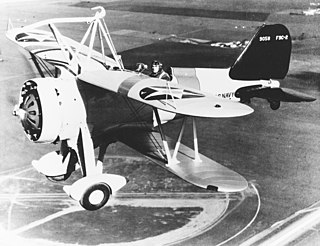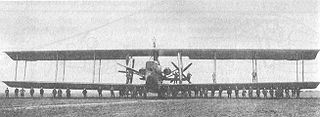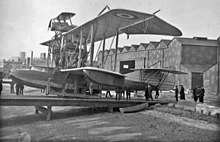
A bomber is a military combat aircraft designed to attack ground and naval targets by dropping air-to-ground weaponry, launching torpedoes, or deploying air-launched cruise missiles. The first use of bombs dropped from an aircraft occurred in the Italo-Turkish War, with the first major deployments coming in the First World War and Second World War by all major airforces causing devastating damage to cities, towns, and rural areas. The first purpose built bombers were the Italian Caproni Ca 30 and British Bristol T.B.8, both of 1913. Some bombers were decorated with nose art or victory markings.
Parnall was a British aircraft manufacturer that evolved from a wood-working company before the First World War to a significant designer of military and civil aircraft into the 1940s. It was based in the west of England and was originally known as George Parnall & Co. Ltd.

A light bomber is a relatively small and fast type of military bomber aircraft that was primarily employed before the 1950s. Such aircraft would typically not carry more than one ton of ordnance.

The McDonnell XF-85 Goblin is an American prototype fighter aircraft conceived during World War II by McDonnell Aircraft. It was intended to deploy from the bomb bay of the giant Convair B-36 bomber as a parasite fighter. The XF-85's intended role was to defend bombers from hostile interceptor aircraft, a need demonstrated during World War II. McDonnell built two prototypes before the Air Force (USAAF) terminated the program.
This is a list of aviation-related events from 1910:
This is a list of aviation-related events from 1914.
This is a list of aviation-related events from 1916:
This is a list of aviation-related events from 1907:

A mother ship, mothership or mother-ship is a large vehicle that leads, serves, or carries other smaller vehicles. A mother ship may be a maritime ship, aircraft, or spacecraft.

World War I was the first major conflict involving the large-scale use of aircraft. Tethered observation balloons had already been employed in several wars, and would be used extensively for artillery spotting. Germany employed Zeppelins for reconnaissance over the North Sea and Baltic and also for strategic bombing raids over Britain and the Eastern Front.

A parasite aircraft is a component of a composite aircraft which is carried aloft and air launched by a larger carrier aircraft or mother ship to support the primary mission of the carrier. The carrier craft may or may not be able to later recover the parasite during flight.

Air launching is the practice of releasing a rocket, missile, parasite aircraft or other aircraft payload from a mother ship or launch aircraft. The payload craft or missile is often tucked under the wing of the larger mother ship and then "dropped" while in flight. It may also be stored within a bomb bay, beneath the main fuselage or even on the back of the carrier aircraft, as in the case of the D-21 drone. Air launching provides several advantages over ground launching, giving the smaller craft an altitude and range boost, while saving it the weight of the fuel and equipment needed to take off on its own.

The Curtiss F9C Sparrowhawk is a light 1930s biplane fighter aircraft that was carried by the United States Navy airships USS Akron and Macon. It is an example of a parasite fighter, a small airplane designed to be deployed from a larger aircraft such as an airship or bomber.

The FICON program was conducted by the United States Air Force in the 1950s to test the feasibility of a Convair B-36 Peacemaker bomber carrying a Republic F-84 Thunderflash parasite fighter in its bomb bay. Earlier wingtip coupling experiments included Tip Tow, which were attempts at carrying fighters connected to the wingtips of bombers. Tom-Tom followed the FICON project afterwards.
An airborne aircraft carrier is a type of mother ship aircraft which can carry, launch, retrieve and support other smaller parasite aircraft.

Sometimes dubbed the Golden Age of Aviation, the period in the history of aviation between the end of World War I (1918) and the beginning of World War II (1939) was characterised by a progressive change from the slow wood-and-fabric biplanes of World War I to fast, streamlined metal monoplanes, creating a revolution in both commercial and military aviation. By the outbreak of World War II in 1939 the biplane was all but obsolete. This revolution was made possible by the continuing development of lightweight aero engines of increasing power. The jet engine also began development during the 1930s but would not see operational use until later.

A Riesenflugzeug, sometimes colloquially referred to in English as an R-plane, was any member of a class of large World War I German bombers, possessing at least three aircraft engines, although usually four or more engines. These were large multi-engine aircraft capable of flying several hours with larger bomb loads than the smaller Grossflugzeug bombers such as the Gotha G.V.
Zveno was a parasite aircraft developed in the Soviet Union during the 1930s. It consisted of a Tupolev TB-1 or a Tupolev TB-3 heavy bomber mothership and two to five fighters. Depending on the variant, the fighters either launched with the mothership or docked in flight, and they could refuel from the bomber. The definitive Zveno-SPB using a TB-3 and two Polikarpov I-16s, each armed with two 250 kg (550 lb) bombs, was used operationally as a strategic weapon system with good results against targets in Romania during the opening stages of the German-Soviet War. The same squadron later carried out an attack against a bridge on the River Dnieper that had been captured by German forces.

The Hillson Bi-mono was a British experimental aircraft of the 1940s. It was designed to test the idea of "slip-wings", where the aircraft could take off as a biplane, jettison the upper, disposable wing, and continue flying as a monoplane. A single example was built, which successfully demonstrated jettisoning of the slip wing in flight.

The Akron-class airships were a class of two rigid airships constructed for the US Navy in the early 1930s. Designed as scouting and reconnaissance platforms, the intention for their use was to act as "eyes for the fleet", extending the range at which the US Navy's Scouting Force could operate to beyond the horizon. This capability was extended further through the use of the airships as airborne aircraft carriers, with each capable of carrying a small squadron of airplanes that could be used both to increase the airship's scouting range, and to provide self-defense for the airship against other airborne threats.













